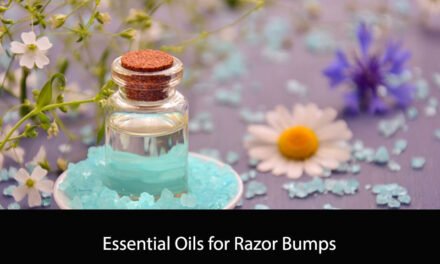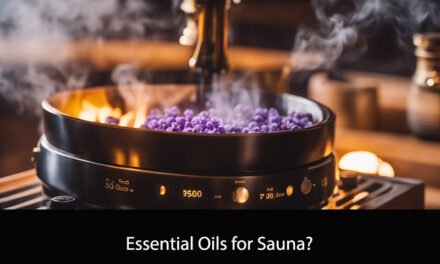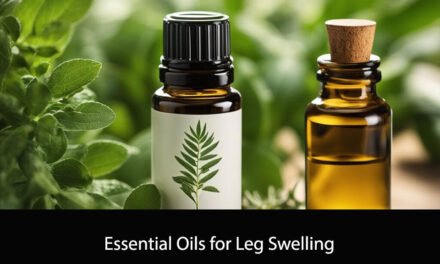Heat rash, also known as prickly heat, is a common skin condition that occurs when sweat ducts become blocked, trapping sweat beneath the skin. This can lead to a rash that is itchy, uncomfortable, and sometimes painful. While heat rash can occur anywhere on the body, it is most common in areas where sweat is trapped, such as the neck, chest, back, and groin.
Many people turn to essential oils as a natural remedy for heat rash. Essential oils are highly concentrated plant extracts that are believed to have therapeutic properties. When used topically, essential oils can help soothe irritated skin, reduce inflammation, and provide relief from itching and discomfort. In this article, we will explore some of the best essential oils for heat rash and how to use them safely and effectively.
Understanding Heat Rash

Heat rash, also known as prickly heat, is a common skin condition that occurs when sweat ducts become blocked and sweat accumulates under the skin. This can lead to irritation, inflammation, and the appearance of small, itchy bumps on the skin.
Causes of Heat Rash
Heat rash is most commonly caused by excessive sweating in hot and humid environments. It can also be caused by wearing tight clothing that traps sweat against the skin or by using heavy creams or lotions that clog the sweat ducts.
Symptoms and Diagnosis
Symptoms of heat rash include small, red bumps on the skin, itching, and a prickly or stinging sensation. In severe cases, blisters may form. Heat rash is usually diagnosed based on the appearance of the skin and the patient’s medical history.
It is important to note that heat rash is a benign condition and does not typically require medical treatment. However, if symptoms persist or worsen, it is recommended to seek medical attention.
To prevent heat rash, it is important to stay cool and dry in hot and humid environments. Loose-fitting clothing made from breathable fabrics such as cotton can also help prevent heat rash. Additionally, avoiding heavy creams or lotions and taking frequent breaks in cool, shaded areas can help reduce the risk of developing heat rash.
Essential Oils Overview
When it comes to treating heat rash, essential oils can be a natural and effective solution. Essential oils are concentrated plant extracts that have been used for centuries for their therapeutic properties. In this section, we will provide an overview of essential oils and their benefits for the skin, as well as tips for selecting quality essential oils.
Benefits of Essential Oils for Skin
Essential oils are known for their anti-inflammatory, antifungal, and antibacterial properties, making them a great option for treating skin conditions like heat rash. Some essential oils, such as lavender and chamomile, have a calming effect on the skin, reducing redness and irritation. Tea tree oil is another popular essential oil that has powerful antimicrobial properties, making it effective in treating bacterial and fungal infections.
Essential oils can also help to moisturize the skin, which is important for preventing further irritation and promoting healing. Many essential oils contain antioxidants, which can help to protect the skin from damage caused by free radicals and environmental stressors.
Selecting Quality Essential Oils
When selecting essential oils for treating heat rash, it is important to choose high-quality oils that are pure and free from additives. Look for oils that are labeled as “therapeutic grade” or “100% pure.” It is also important to purchase essential oils from a reputable source to ensure their quality and purity.
When using essential oils, it is important to dilute them properly before applying them to the skin. Essential oils are highly concentrated and can cause skin irritation if used undiluted. Always follow the recommended dilution ratios and patch test a small area of skin before applying essential oils to a larger area.
In summary, essential oils can be a natural and effective solution for treating heat rash. They offer a variety of benefits for the skin, including anti-inflammatory, antifungal, and antibacterial properties. When selecting essential oils, it is important to choose high-quality oils that are pure and free from additives, and to dilute them properly before use.
Best Essential Oils for Heat Rash

When it comes to treating heat rash, essential oils can be a great natural remedy. Here are some of the best essential oils for heat rash:
Lavender Oil
Lavender oil has anti-inflammatory and antiseptic properties that can help soothe and heal heat rash. It also has a calming effect on the skin, which can help reduce itching and discomfort. To use lavender oil for heat rash, mix a few drops with a carrier oil like coconut oil and apply to the affected area.
Chamomile Oil
Chamomile oil is another essential oil that has anti-inflammatory properties. It can help reduce redness and swelling associated with heat rash. Chamomile oil can also help reduce itching and promote healing. To use chamomile oil for heat rash, mix a few drops with a carrier oil and apply to the affected area.
Tea Tree Oil
Tea tree oil has antibacterial and antifungal properties that can help prevent infection in heat rash. It also has anti-inflammatory properties that can help reduce redness and swelling. To use tea tree oil for heat rash, mix a few drops with a carrier oil and apply to the affected area.
Peppermint Oil
Peppermint oil has a cooling effect on the skin, which can help reduce itching and discomfort associated with heat rash. It also has anti-inflammatory properties that can help reduce redness and swelling. To use peppermint oil for heat rash, mix a few drops with a carrier oil and apply to the affected area.
Overall, essential oils can be a great natural remedy for heat rash. However, it’s important to use them properly and dilute them with a carrier oil before applying to the skin. If you experience any adverse reactions, stop using the essential oil immediately and seek medical attention.
Application Methods
Topical Application
When it comes to treating heat rash with essential oils, topical application is one of the most effective methods. Diluting essential oils with a carrier oil before applying them to the affected area is highly recommended to avoid any skin irritation or complications.
Some of the carrier oils that work well with essential oils for heat rash include coconut oil, almond oil, and jojoba oil. These carrier oils have moisturizing properties that can help soothe the affected skin, while also helping the essential oils penetrate the skin more effectively.
To apply the diluted essential oils, gently massage the mixture onto the affected area using circular motions. Repeat this process two to three times daily until the rash subsides.
Aromatic Use
In addition to topical application, aromatic use of essential oils can also help alleviate the symptoms of heat rash. This method involves inhaling the essential oils either directly or by using a diffuser.
To use essential oils aromatically, add a few drops of the oil to a diffuser filled with water and turn it on. Alternatively, you can add a few drops of the oil to a bowl of hot water and inhale the steam.
Some of the essential oils that work well for aromatic use in treating heat rash include lavender, tea tree, peppermint, and chamomile. These oils have anti-inflammatory and soothing properties that can help reduce the redness and itching associated with heat rash.
In conclusion, both topical application and aromatic use of essential oils can be effective in treating heat rash. However, it is important to use caution and dilute the oils properly to avoid any adverse reactions.
Safety and Precautions

When using essential oils for heat rash, it is important to take certain safety precautions to avoid any negative side effects. Here are a few guidelines to follow:
Dilution Guidelines
Essential oils are highly concentrated and should always be diluted before use. We recommend diluting essential oils with a carrier oil such as coconut, almond, or jojoba oil. A general rule of thumb is to use 1-2 drops of essential oil per teaspoon of carrier oil. However, some essential oils may require a higher or lower dilution ratio, so it is important to do your research before use.
Patch Testing
Before using any essential oil for the first time, it is important to do a patch test to check for any allergic reactions. To do this, dilute the essential oil as recommended and apply a small amount to a patch of skin on your inner arm. Wait 24-48 hours to see if any redness, itching, or irritation occurs. If there is no reaction, the oil is likely safe for use.
Possible Side Effects
While essential oils can be beneficial for treating heat rash, they can also have negative side effects if not used properly. Some possible side effects include skin irritation, allergic reactions, and photosensitivity. It is important to avoid using certain essential oils if you are pregnant, nursing, or have certain medical conditions. Always consult with a healthcare professional before using essential oils for any medical condition.
By following these safety precautions, you can safely and effectively use essential oils to treat heat rash.
Integrating Essential Oils into Your Routine
When it comes to heat rash, incorporating essential oils into your daily routine can help soothe and prevent further irritation. Here are a few ways to integrate essential oils into your skincare routine:
Daily Skincare
Adding essential oils to your daily skincare routine can help prevent heat rash from occurring. We recommend mixing a few drops of essential oil with a carrier oil, such as coconut or jojoba oil, and applying it to the affected area after showering. Some essential oils that are particularly effective for heat rash include:
- Lavender oil: known for its anti-inflammatory properties, lavender oil can help reduce redness and irritation.
- Tea tree oil: has antifungal and antibacterial properties, which can help prevent infection and soothe the skin.
- Peppermint oil: can help cool and soothe the skin, reducing itching and discomfort.
Heat Rash Prevention Tips
In addition to incorporating essential oils into your skincare routine, there are a few other steps you can take to prevent heat rash:
- Wear loose, breathable clothing: tight clothing can trap sweat and heat against the skin, leading to heat rash.
- Stay cool: try to avoid spending too much time in hot, humid environments.
- Keep skin dry: pat your skin dry after showering or sweating to prevent moisture from building up.
By incorporating essential oils into your daily skincare routine and taking steps to prevent heat rash, you can help keep your skin healthy and comfortable.
Alternative Remedies and Support

Hydration and Diet
Staying hydrated is crucial to avoid heat rash. Drinking plenty of water and fluids can help to keep the body cool and hydrated. It is also important to avoid hot and spicy foods that can increase body temperature and cause sweating, leading to more irritation and rash.
Wearing Breathable Clothing
Wearing loose and breathable clothing made of cotton or other natural fibers can help to prevent heat rash. Avoid tight-fitting clothes and synthetic fabrics that trap moisture and heat, causing more irritation and rash.
Cooling Therapies
Cooling therapies such as taking a cool shower or bath, applying a cool compress, or using a fan can help to alleviate symptoms of heat rash. Avoid using ice or very cold water as it can further irritate the skin.
In addition to these alternative remedies, it is important to avoid scratching the affected area as it can worsen the rash and lead to infection. If the rash persists or becomes severe, it is recommended to seek medical advice.
Frequently Asked Questions
What is the most effective essential oil for treating skin rashes?
There are several essential oils that can help alleviate skin rashes, but the most effective one is lavender oil. Lavender oil has anti-inflammatory and antiseptic properties that can help soothe and heal the skin.
How can tea tree oil be used to alleviate heat rash symptoms?
Tea tree oil is a natural antiseptic and anti-inflammatory agent that can help reduce itching and inflammation caused by heat rash. Mix a few drops of tea tree oil with a carrier oil, such as coconut oil, and apply it to the affected area.
Are there specific essential oils recommended by doTERRA for skin rashes?
Yes, doTERRA recommends using Lavender, Melaleuca, and Frankincense essential oils for skin rashes. These oils have anti-inflammatory and antiseptic properties that can help soothe and heal the skin.
Can peppermint oil provide relief for heat rash discomfort?
Peppermint oil has a cooling effect on the skin and can help reduce the discomfort caused by heat rash. Mix a few drops of peppermint oil with a carrier oil, such as almond oil, and apply it to the affected area.
What essential oils are known to help with skin allergies and reactions?
Tea tree oil, lavender oil, and chamomile oil are known to help with skin allergies and reactions. These oils have anti-inflammatory and antiseptic properties that can help soothe and heal the skin.
How can one quickly reduce the symptoms of heat rash using essential oils?
Mix a few drops of lavender oil and tea tree oil with a carrier oil, such as jojoba oil, and apply it to the affected area. This will help reduce inflammation and soothe the skin. Additionally, applying a cold compress to the affected area can also help reduce symptoms.





